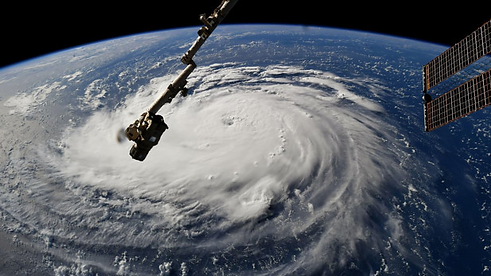Water tracers, tropical storms, and hydrological processes
Tropical and extra-tropical cyclones, such as Katrina, Harvey, Eta, Iota, Ian, Ida, and Sandy posed a significant climatic threat to the US and Mesoamerican coastal regions. Despite the well-known Atlantic/Caribbean Sea hurricane season, there is no detailed ground-based information about the interaction of TS incursions and the propagation of isotopically distinct pulses across surface and subsurface water reservoirs, both in inland and urban coastal regions. The latter precludes the use and development of isotope-aided metrics and modeling to evaluate runoff generation, groundwater recharge (vulnerability/susceptibility), and baseflow recessions during/after these extreme events. This existent issue highlights the importance of process-based studies of modern-day rainfall, groundwater, and surface water isotope distributions on daily to inter-annual timescales.
See these publications: https://doi.org/10.1111/nyas.15274

Monsoon Evolution from Northern Mexico to Southwestern US
A large debate still exists about the relative moisture contribution to the North America Monsoon System (NAMS) from the Pacific Ocean/Gulf of California, the Gulf of Mexico, and terrestrial sources. To evaluate the spatio-temporal evolution of the NAMS, daily rainfall for triple water isotopes analysis is being collected along a transect from northern Mexico to southwester US. The sampling sites include: Albuquerque, New Mexico, USA (by Dr. Mark Stone; stone@unm.edu), Ciudad Juárez, Chihuahua, México (by Dr. Felipe Adrián Vásquez; fvazquez@uacj.mx), and Ciudad Obregón, Sonora, México (by Dr. Enrico Yepez; enrico.yepez@itson.edu.mx). Two sampling campaigns have been conducted 2022-2023. Two students have collaborated with sampling campaigns: Omar López-Mirelles (Universidad de Ciudad Juárez) and Kritan Subedi (University of New Mexico).

Urban hydrology in the Dallas-Fort Worth Metroplex
Persistent droughts and extreme precipitation events coupled with increasing water needs are shaping the co-evolution of Texas's urban assemblages, water laws/regulations, stormwater management, and future water supply allocation. In large metroplex areas such as Dallas-Fort Worth, the spatial and temporal, variability of water inputs to streams is altering the ecohydrological conditions in urban watersheds. Therefore, there is an urgent need to determine the relationship between urban stream health, the extent of impervious surfaces, and rainfall-runoff generation. Water cycle changes in urbanized landscapes may include a) decrease in infiltration and an increase in surface runoff (i.e., more impervious surfaces), b) a rapid transport (lack of natural buffering) of emergent pollutants to urban streams, c) a decrease in evapotranspiration, and d) potential shallow urban groundwater recharge. These processes may also be exacerbated by changes in rainfall amount and intensity under changing climate scenarios.

Mapping tap water distribution using isotope-based metrics: DFW (USA) and Gaborone (Botswana)
Persistent droughts coupled with increasing water needs are shaping the co-evolution of socioeconomic assemblages, water laws/regulations and future water supply allocation. This research focuses on understanding tap water systems using naturally occurring isotope tracers. The project's main goal is to produce new urban isotope-informed data with key water supply information related to the effects of rapid urban growth and climate variability on surface water reservoirs. Both study regions, DFW, USA and the City of Gaborone, Botswana share a sub-tropical climate (sub-tropical humid and arid, respectively) and surface water reservoirs as the primary tap water source, with significant differences in water infrastructure and allocation. The isotope sampling campaigns are designed to capture seasonal variations during at least two hydrological years. Emerging patterns (in time and space) will advance the understanding of water movement, use, and availability on urban supply systems in the light of inter-annual climate variability (e.g., ENSO), climate change and prolonged droughts.
See this publication: https://doi.org/10.1002/hyp.15312

Water partitioning in the Chihuahua Desert
The Chihuahua Desert, in southwestern Texas, has been transitioning from prolonged droughts to active monsoon seasons in the last decade. In this region, cactus is one the most representative specimen of desert plants and offer a large spectrum of outstanding strategies for optimal water management. However, there is a large knowledge gap in understanding how these plants are adapting soil water uptake under a changing climate.

Serpentinization and hydrological controls on natural hydrogen production
The discovery of widespread, natural H2 seepages offers enormous potential for carbon-free energy-based solutions. Low-temperature serpentinization, the process off aqueous alteration of low-silica ultramafic rocks, has been regarded as one of the major pathways of continental H2 production. Our research focuses specifically on constraining natural mechanisms of H2 generation, storage, and release in an active serpentinization environment of Costa Rica. This project entails integrating hydrometric, geochemical, and tracer techniques to elucidate the key drivers controlling the relatively rapid and in-situ production of subsurface H2 in the Santa Elena Ophiolite, Costa Rica.
See this publication: https://doi.org/10.1002/2013GC005213
